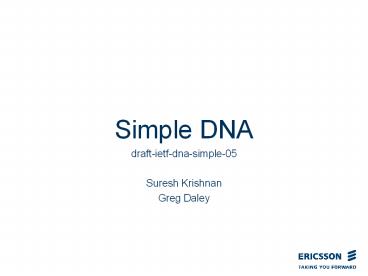Simple DNA - PowerPoint PPT Presentation
Title:
Simple DNA
Description:
... Choi and Alfred Hoenes reviewed the document and provided comments (Thanks! ... Progressing the document. Before the next IETF meeting if everything goes well ... – PowerPoint PPT presentation
Number of Views:84
Avg rating:3.0/5.0
Title: Simple DNA
1
Simple DNA
- draft-ietf-dna-simple-05
- Suresh Krishnan
- Greg Daley
2
Status
- Most issues have been resolved
- One major issue remains. Resolving this will
resolve another newly raised issue. - Received several reviews
- Bernard Aboba, Julien Laganier, Domagoj Premec,
Jin Hyeock Choi and Alfred Hoenes reviewed the
document and provided comments (Thanks!) - Issues being tracked at the issue tracker
- http//tools.ietf.org/wg/dna/trac/report/9 lists
all issues (both open and closed) - http//tools.ietf.org/wg/dna/trac/report/1 lists
open issues
3
Issue 8 Describe identification model of simple
dna
- ISSUE Previously DNA relied on link
identification. So a host verifies all addresses
(and IP parameters) at a stroke. However Simple
DNA aims to verify IP address (and IP parameter)
per router. I propose we write down the change
clearly. - SUBMITTER Jin Hyeock Choi
- STATUS Resolved
- RESOLUTION Added text to indicate that describes
the router probing based identification model for
Simple DNA. Also clarified that this is different
from the model followed by complete dna.
4
Simple DNA Identification model
- Earlier methods of detecting network attachment,
e.g. the procedure defined in I-D.ietf-dna-protoc
ol, relied on detecting whether the host was
still connected to the same link. If the host was
attached to the same link, all information
related to the link such as the routers, prefixes
and configuration parameters was considered to be
valid. The Simple DNA protocol follows an
alternate approach where it relies on probing
each previously known router to determine whether
to use information learnt from THAT router. This
allows simple DNA to probe routers learnt from
multiple earlier attachments to optimize movement
between a known set of links.
5
Issue 9 Detailed description of ND packets
- ISSUE Simple dna needs to document a detailed
description of the contents of ND and RS packets
(such as included options, and source/dest
addresses). - SUBMITTER Bernard Aboba
- STATUS Resolved
- RESOLUTION New section 4.5 added that describes
the contents of the ND packets (NS and RS) sent
out by the Simple DNA process.
6
Issue 10 Pseudo Code
- ISSUE It would be helpful to have some pseudo
code describing the simple dna process. - SUBMITTER Jin Hyeock Choi
- STATUS Resolved
- RESOLUTION Pseudo code has been added to a new
section in the Simple DNA draft (section 6)
7
Issue 11 Applicability statement
- ISSUE This document needs an applicability
statement that describes the scenarios under
which it is useful. - SUBMITTER Jin Hyeock Choi
- STATUS Resolved
- RESOLUTION New section containing the
applicability statement (section 2.2) has been
added. The old applicability section (badly
named) has been moved to a new section called
Working assumptions (section 2.5).
8
Applicability Statement
- The Simple DNA protocol provides substantial
benefits in some scenarios and does not provide
any benefit at all in certain other scenarios.
This is intentional as Simple DNA was designed
for simplicity rather than completeness. In
particular, the Simple DNA protocol provides
maximum benefits when a host moves between a
small set of known links. When a host moves to a
completely new link that is previously unknown,
the performance of the Simple DNA protocol will
be identical to that using standard neighbor
discovery.
9
Issue 12 When to perform DAD
- ISSUE Simple DNA should describe the conditions
under which DAD should be performed. - SUBMITTER Erik Nordmark, Bernard Aboba, Jin
Hyeock Choi, Dave Thaler - STATUS Open
- RESOLUTION Need a discussion
10
Issue 13 Include SLLAO
- ISSUE We need to include SLLAO in the NS probes
- SUBMITTER Bernard Aboba
- STATUS Open
- RESOLUTION Can be resolved right after we agree
on the DAD text. The only reason for a node to
not include an SLLAO is that it has not performed
DAD on the address.
11
Way forward
- Any more open/outstanding issues?
- Not aware of any but feel free to raise them
- Reviews
- Do we need wider reviews of this document
- Implementer feedback
- Host/router vendors who have plans to implement
this proposal - Progressing the document
- Before the next IETF meeting if everything goes
well































